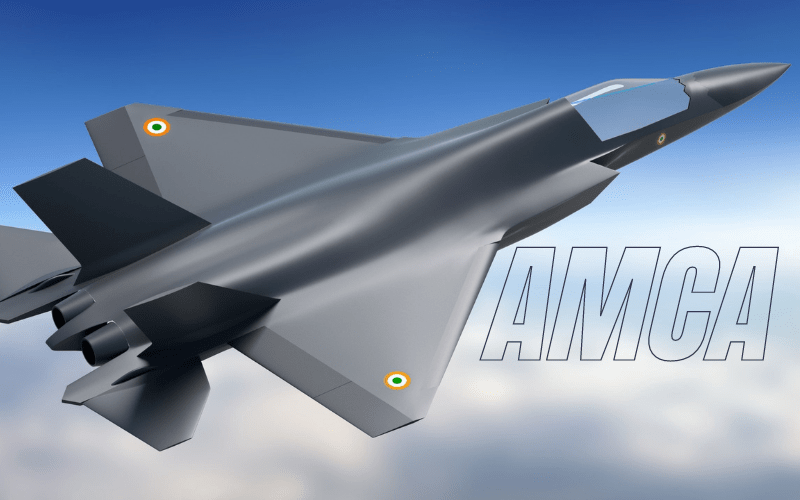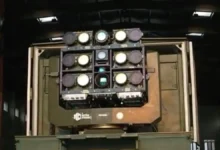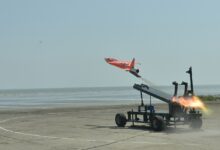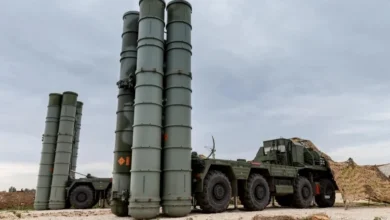India’s 5.5 Generation AMCA Is Probably Aiming To Catch China, As Per International Media.

Hindustan Aeronautics Limited (HAL), an Indian aerospace corporation, has declared the start of the manufacturing process for India’s Advanced Medium Combat Aircraft (AMCA) (AMCA).
The initial sheet metal was cut by India’s Defence Research and Development Organization (DRDO) and HAL, as is customary when the aircraft production process begins.
The AMCA seeks to provide a 5.5 generation twin-engine stealth fighter to the Indian Air Force and Navy, replacing India’s old SEPECAT Jaguar and Dassault Mirage 2000 fighters and supplementing its license-built Sukhoi Su-30MKI jets.
It’s a multirole fighter capable of air superiority, ground strikes, enemy air defence suppression, and electronic warfare missions. Its mission is to carry out deep strikes into enemy territory in order to eliminate air defences and other key objectives.
Supercruise, diverter-less supersonic intakes, improved avionics, and artificial intelligence are among the advanced technology envisioned for the aircraft. In baseline stealth mode, the aircraft will have a combat weight of 20 tonnes and be capable of carrying 1.5 tonnes of munitions in its internal weapons bays.
The AMCA will carry a 23-millimeter cannon and an additional five tonnes of fuel and weaponry on 14 external hardpoints in non-stealth configuration, however this will undoubtedly increase the aircraft’s radar cross-section.
The AMCA will also have three-dimensional thrust vectoring and an active electronically scanned array (AESA) radar built in the United States. The AMCA’s first two squadrons in the Mark 1 version will be powered by a pair of General Electric F414-INS6 turbofan engines, each rated at 98 kilonewtons of thrust.
Supercruise, on the other hand, will not be possible until 110 kN-class engines are constructed. An indigenously developed 125 KN engine co-produced by DRDO and French jet engine company Safran is intended to power another five squadrons in the more advanced Mark 2 version.
It is expected to reach a top speed of 2,600 km/h (Mach 2.15) and a combat range of 1,620 kilometres.
While HAL and India’s Aeronautical Development Agency (ADA) are in charge of designing the AMCA, the country also intends to enlist the help of the private sector to cut development and production costs. Since 2009, the ADA has been working on the AMCA, with the first prototype expected to be finished by 2024 and the first flight scheduled for 2025.
The need to catch up to China, maintain qualitative military dominance over Pakistan, and increase strategic autonomy over critical military technology may be driving India’s 5th generation fighter project.
China currently operates the J-20 and FC-31 5th generation stealth aircraft, which might be employed against India in their Himalayan border disputes. The 4.5 generation French-built Rafale and license-built 4+ generation Russian Su-30MKI planes, on the other hand, are India’s most capable air superiority fighters.
While the capabilities of China’s 5th generation aircraft are unknown at this time, the generation gap between them and India’s current fighters could place India at a disadvantage in an aerial battle over the Himalayas.
The AMCA is also intended to counteract Pakistan’s 5th generation fighter programme, which it is developing in collaboration with Turkey. India’s AMCA, combined with its newer Rafale acquisitions, may be able to outperform Pakistan’s older F-16s, JF-17s, J-10Cs, Dassault Mirage IIIs, Dassault Mirage 5s, and Chengdu F-7PGs in terms of quality.
In addition, by boosting India’s domestic aerospace sector, the AMCA programme strengthens India’s strategic autonomy over crucial military technology and hardware. Furthermore, when it comes to maintaining strategic autonomy, India and France are on the same page, as both are apprehensive of being relegated to second-class citizens under a US-led security framework.
So, combined with other defence buys from France, such as the Scorpene-class submarines and Rafale fighter jets, technology exchange between the two countries helps to create a defence alliance free of perceived US involvement.
However, India’s AMCA project confronts financial and technical challenges. Only the F-22, F-35, J-20, and Su-57 are currently operational, indicating that the production of these 5th generation fighter jets is a very expensive and complex enterprise.







Facebook Comments